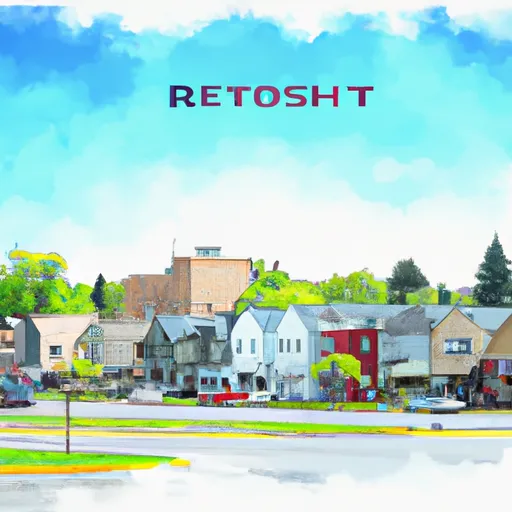-
 Snoflo Premium
Snoflo Premium
Get unlimited access to all our content
With no Ad interruptions! - Start Your Free Trial Login with existing account
Ellsworth
Eden Index
Climate
6.8
•
Recreation
6.2
•
Community
0.9
•
Safeguard
5.1/10

Ellsworth, Michigan is a small village located in Antrim County. The climate in Ellsworth is considered humid continental, with warm summers and cold winters. The area is known for its abundant water resources, with several rivers and lakes nearby. The Jordan River, in particular, is a popular destination for fishing and kayaking. The hydrology constituents of the area also support agriculture, with many farmers utilizing the water resources for irrigation. Outdoor recreation opportunities in Ellsworth include hiking, camping, fishing, and hunting. The Grass River Natural Area and the Antrim County State Game Area are both popular spots for outdoor enthusiasts. Overall, Ellsworth offers a variety of opportunities for those who enjoy the great outdoors.
What is the Eden Index?
The Snoflo Eden Index serves as a comprehensive rating system for regions, evaluating their desirability through a holistic assessment of climate health, outdoor recreation opportunities, and natural disaster risk, acknowledging the profound impact of these factors on livability and well-being.
Climate Health Indicator (CHI): 6.8
Ellsworth receives approximately
813mm of rain per year,
with humidity levels near 80%
and air temperatures averaging around
8°C.
Ellsworth has a plant hardyness factor of
5, meaning
plants and agriculture in this region thrive during a short period during spring and early summer. Most
plants will die off during the colder winter months.
By considering the ideal temperature range, reliable water supplies, clean air, and stable seasonal rain or snowpacks, the Climate Health Indicator (CHI) underscores the significance of a healthy climate as the foundation for quality living.
A healthy climate is paramount for ensuring a high quality of life and livability in a region, fostering both physical well-being and environmental harmony. This can be characterized by ideal temperatures, reliable access to water supplies, clean air, and consistent seasonal rain or snowpacks.
Weather Forecast
Streamflow Conditions
Northeastern Lake Michigan
Area Rivers
Northeastern Lake Michigan
Snowpack Depths
Northeastern Lake Michigan
Reservoir Storage Capacity
Northeastern Lake Michigan
Groundwater Levels
Recreational Opportunity Index (ROI): 6.2
The Recreational Opportunity Index (ROI) recognizes the value of outdoor recreational options, such as parks, hiking trails, camping sites, and fishing spots, while acknowledging that climate plays a pivotal role in ensuring the comfort and consistency of these experiences.
Access to outdoor recreational opportunities, encompassing activities such as parks, hiking, camping, and fishing, is crucial for overall well-being, and the climate plays a pivotal role in enabling and enhancing these experiences, ensuring that individuals can engage in nature-based activities comfortably and consistently.
Camping Areas
| Campground | Campsites | Reservations | Toilets | Showers | Elevation |
|---|---|---|---|---|---|
| Tahquamenon Falls 2 State Park | 90 | 752 ft | |||
| Culhane Lake - State Forest | 22 | 635 ft | |||
| Garnet Lake - State Forest | 10 | 842 ft | |||
| Black River - State Forest | 12 | 656 ft | |||
| Mouth of Two Hearted River - State Forest | 39 | 615 ft | |||
| Shelldrake Dam - State Forest | 18 | 648 ft | |||
| Epoufette Township Park | 5 | 588 ft | |||
| Pike Lake (Paradise) - State Forest | 23 | 690 ft | |||
| Hog Island Point - State Forest | 59 | 587 ft | |||
| Bodi Lake - State Forest | 20 | 650 ft |
Nearby Ski Areas
Catastrophe Safeguard Index (CSI):
The Catastrophe Safeguard Index (CSI) recognizes that natural disaster risk, encompassing floods, fires, hurricanes, and tornadoes, can drastically affect safety and the overall appeal of an area.
The level of natural disaster risk in a region significantly affects safety and the overall livability, with climate change amplifying these risks by potentially increasing the frequency and intensity of events like floods, fires, hurricanes, and tornadoes, thereby posing substantial challenges to community resilience and well-being.
Community Resilience Indicator (CRI): 0.9
The Community Resilience Indicator (CRI) recognizes that education, healthcare, and socioeconomics are crucial to the well-being of a region. The CRI acknowledges the profound impact of these elements on residents' overall quality of life. By evaluating educational resources, healthcare accessibility, and economic inclusivity, the index captures the essential aspects that contribute to a thriving community, fostering resident satisfaction, equity, and social cohesion.

